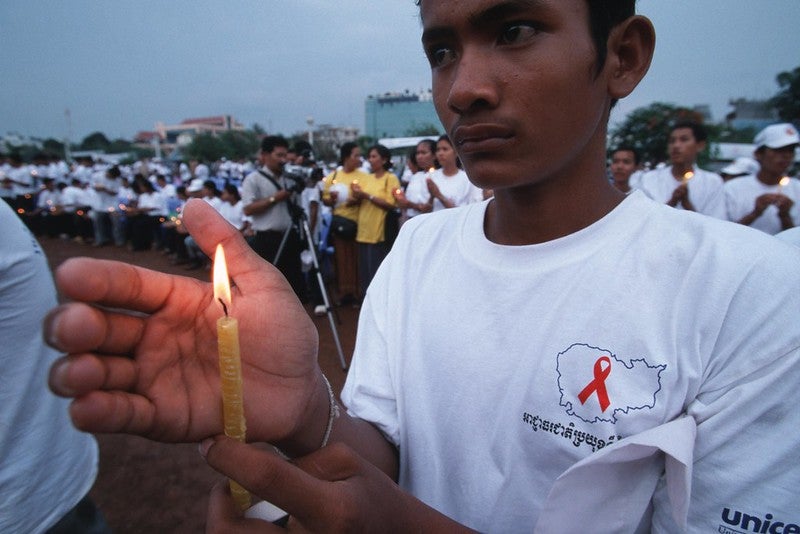1. The global community launched an unprecedented response to the AIDS epidemic
Almost two decades ago, the World Bank mobilized IDA, the World Bank’s fund for the poorest countries, to launch the Multi-Country AIDS Program, the first billion-dollar response to the AIDS epidemic. This was followed by the US President’s Emergency Plan for AIDS Relief, PEPFAR and the formation of the Global Fund. To date, PEPFAR and the Global Fund have secured approximately USD 150 billion (USD 90 billion and USD 60 billion respectively). This unprecedented response, together with increasingly effective and simple treatments for HIV, has changed the contours of the HIV epidemic.
2. Significant progress has been made, but more needs to be done
Today almost 25 million of the 38 million people living with HIV receive treatment. This is significant progress not only for HIV responses, but for countries‘ efforts to achieve SDG3 and universal health coverage. Success in HIV is progress toward Universal Health Care and progress toward SDG3. AIDS-related mortality has fallen by up to 80% and life expectancy in the worst affected countries is now higher than before the epidemic. We have been less successful in reducing new infections. While new infections have fallen by 28% in Eastern and Southern Africa, elsewhere the overall decline is only 4% and the epidemic continues to grow in some regions - by 29% in Eastern Europe and Central Asia, 10% in the Middle East and North Africa and by 7% in Latin America and the Caribbean.
Despite the extraordinary success of AIDS treatment, it is clear we will be living with AIDS throughout this century and we must therefore pivot from an emergency response to a long-term developmental response; one that is integrated into primary care systems, with integrated financing and service delivery models and with a strong focus on primary prevention. It will be important to focus not only on expanding access to and improving the quality of treatment services, but to also reduce disease burden by expanding prevention. We need to focus on keeping people healthy, not just diagnoses and sick-care.
3. IDA, the World Bank’s fund for the poorest plays an important role to finance HIV-AIDS programs as countries march towards progress on Universal Health Coverage
The reliance of the HIV response on international financing and its exclusion from domestic health financing schemes is of particular concern. Contrast HIV and TB. About US%1 billion of an estimated annual TB budget of US$9 billion, around 11%, is internationally financed. In contrast, international financing still accounts for up to 75% of HIV financing in many of the highest burden countries.
The UNGA Political Declaration on Universal Health Coverage, launched at the United Nations General Assembly in September 2019, emphasizes the need for integrated services and financial protection. It also urges governments to allocate at least 1% of GDP spent on primary healthcare services. This is an unprecedented opportunity for the HIV response integration efforts. But it should be done in a way that recognizes community-based service delivery ensures the protection and safe access to HIV services for marginalized populations.
As we mark World AIDS Day on December 1 and look forward to Universal Health Coverage Day on December 12, it is clear that IDA has an important role to play in assisting countries to integrate HIV into strengthened domestic health financing initiatives.
4. Key actions in the fight against AIDS need to take a holistic approach within and beyond the health sector
Promote economic growth which in turn can increase domestic health financing -- there are no good options without growth;
- Increase the share of government budgets allocated to health and ensure AIDS-related services are included;
- Transform an estimated half a trillion dollars annually in inefficient, expensive out-of-pocket health spending into prepaid, risk pooling plans - which underpin successful UHC schemes in many countries;
- Progressively integrate HIV into expanding primary care services, while ensuring marginalized communities continue to be served;
- Focus on the poorest and most fragile countries, who lack viable domestic financing pathways;
- Use data and predictive analytics – and technology innovation – to strengthen, expand, target and focus and improve the quality of HIV services
- Redouble our focus on scientific and technological progress, for vaccine and better drugs and diagnostics and more efficient delivery systems, aided by data science and technological innovation;
- Strengthen our focus on health promotion and disease prevention;
- Strengthen social drivers by harnessing the power of other sectors such as education and social protection, which play a proven role in reducing HIV infection.
5. By being successful in HIV, countries are making progress in achieving UHC for their countries
Two decades on, the role of IDA has evolved from an emerging individual disease global trailblazer to a builder of national health financing and delivery systems under the aegis of UHC - and its role remains as relevant as ever.





Join the Conversation